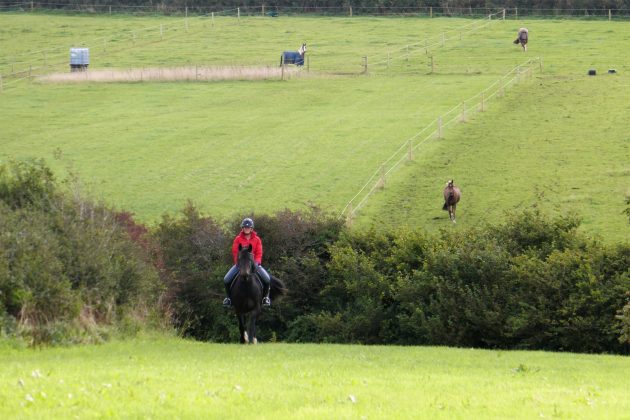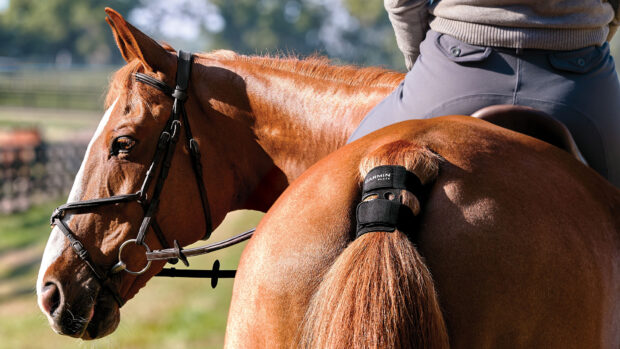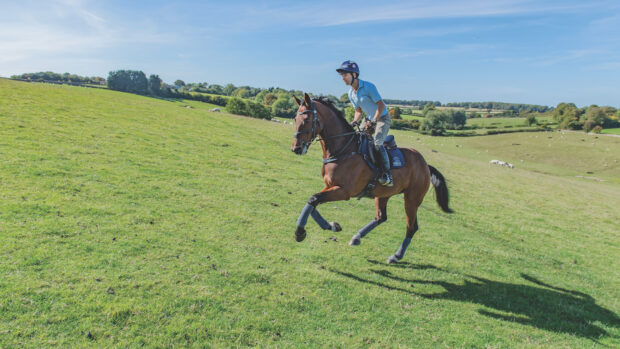Hillwork is beneficial for horses across a range of disciplines.
Working on a gradient boosts cardiovascular fitness, and musculoskeletal strength and conditioning; it also helps enhance a horse’s balance and the body awareness known as proprioception.
Hillwork can be incorporated into hacking or carried out over grass fields and turf or all-weather gallops and may include long, slow distance work and faster canter or gallop work – both of which are required for optimum fitness.
A horse moving uphill is working against gravity, which increases exercise intensity. It takes more effort for the horse to travel the same distance up a slope than on the flat, so slow hillwork can be better for building muscle strength.
Cardiac output is also increased during hillwork, as greater blood flow is necessary to supply oxygen to these harder-working muscles. Cardiovascular fitness is improved by increasing the efficiency of the heart and the circulation and by an improved aerobic capacity, due to adaptations in the muscle and cardiovascular systems. However, there is virtually no increase in the capacity of the lungs and ventilatory system as a result of training.
Strength and conditioning is important in all disciplines. An event horse going across country does not rely purely on cardiovascular fitness; he must stay in balance over the twists and turns in preparation for the fences and when jumping, landing and moving away.
Similarly, a three-year-old running in the Derby is tested not only by the speed of the race, but by the unique changes in camber and the undulating terrain at Epsom, so he will need strength and balance to maintain his position.
Muscle groups are used to different extents according to gradient. When going uphill, loading on the forelimbs is reduced compared to when moving on the flat and the quarters, back and neck muscles work harder. Going downhill strengthens the pectoral, shoulder and forearm muscles, while the quadriceps muscles of the hindlimbs must stabilise and balance the horse.
The quadriceps support the patella and stifle, so work both up and downhill is good for improving stifle stability. This may benefit young horses and those with fixation or delayed release of the patella – where the medial patellar ligament remains hooked over the medial trochlea ridge of the femur, often due to poor muscle tone or straight hindlimb conformation. Introduce this work gradually, on a gentle incline.
Tendons cannot be conditioned after they reach maturity, at about two years of age. The tendons connect muscle to bone; in a mature horse, it is the muscle that can be conditioned by training.
However, since tendons are more prone to injury when a horse is fatigued, improving muscular fitness can help. Damage to tendons is also caused by repetitive strain and peak loading during faster work. Working uphill reduces tendon loading by decreasing the vertical force and also by allowing the same cardiovascular work to be carried out at a slower speed.
Varied workload
Gradients can benefit showjumpers and dressage horses, as well as eventers and racehorses. Cross-training and variety will condition different muscle groups and can have a protective effect on the muscles, tendons and ligaments used repetitively in regular skills training.
Both strength and balance can be improved if a horse is worked downhill at walk, trot and canter. A session involving work up and down is most beneficial – for example, hacking back down a gallop perhaps or using a sloping field, so you can canter a circuit downhill as well as up and also cross the incline.
A horse uses his head and neck to balance when moving and jumping. Allowing him to work with a long neck on a contact, rather than a loose rein, and use his neck during training and exercise will encourage the correct development of neck and back muscles and strengthen his topline. This will bring benefits in any discipline, as a correctly strengthened neck is important for flatwork, jumping and galloping.
Proprioceptors are embedded in the muscle fibres at the junction of muscles and tendons and also within the joint capsules. These give the horse continuous information about his limb position and joint movement, which is essential for joint stability and the performance of complex movements.
When a horse works on a consistent surface, such as an arena, there is little variability in footfall. Therefore, moving across varying terrain and going, including hills, improves his proprioceptive control and will result in better preparation of his nerves, joints and muscles for when he is tested in a competition situation – on uneven ground, for example, or when he must make a quick recovery from a turn or slip. This can in turn help minimise injury and maximise performance.
Learning curve
Hillwork should be introduced gradually to allow the horse’s body and limbs to adapt to the surface and incline. Trying to do too much in one session, before he has acclimatised, will increase injury risk. For example, if you transport your horse to a gallop for the first time, a gentle canter may be all that is necessary to allow him to get used to the surface and terrain. This can then be built up on subsequent visits.
The steeper the incline, the more work the horse must do over the same distance. He may need to travel slower up a steeper hill, although the greater muscular effort required by the incline means that the same heart rate may be achieved at a slower speed. A steeper gallop will stimulate a quicker increase in heart rate.
As with any exercise, variety is important to allow the body to recover from each training session and build the appropriate muscular responses before these are tested again. While fast work on hills should be carried out at appropriate intervals within a planned fitness programme, steady hillwork, such as hacking, can be a part of daily exercise.
Where there is no access to inclines, some of the benefits can be gained through water treadmill work, polework, cavaletti exercises and walking in the sea; all will help strengthen the back and neck muscles, albeit without the same cardiovascular gains. Swimming may encourage greater cardiovascular fitness, but will not work the same muscle groups as hillwork.
How to best use hills
- Warm up and cool down appropriately, to prepare the horse’s muscles for strenuous exercise and to assist recovery.
- Make sure that his body is worked symmetrically, to encourage even muscle development and minimise any uneven loading on the limbs. It’s important to canter and gallop on both left and right leads for similar periods. Any unevenness of gait or a tendency to “hang” in one direction should be investigated before an injury or lameness develops.
- Hillwork may not be ideal for horses with certain injuries or conditions. Sacroiliac pain may be aggravated by going up or down steep hills, so a gentle incline is better for training horses with this condition. Some hillwork is beneficial, however, to build muscle through the thoracolumbar region and to help strengthen the muscles that support the sacroiliac region.
- Some tendon and ligament injuries, especially those in the hindlimbs, can be caused or aggravated by pushing too hard up a steep hill. An inconsistent surface can also contribute to the risk of these injuries. Be aware of how the horse is coping with the terrain and footing; do not push him harder than conditions safely allow.
The author: Liz Brown MRCVS focuses on the performance horse in eventing, racing and dressage. She is an FEI vet for eventing and the team vet for the British eventing team. She attended the Tokyo, London and Rio Olympic Games in this capacity and continues to work with the team.
You might also be interested in:

How to form a fitness plan for your horse

Learn how to strengthen your horse at home using polework

What should you do with your horse the day before an event? H&H investigates…

Subscribe to Horse & Hound magazine today – and enjoy unlimited website access all year round
Horse & Hound magazine, out every Thursday, is packed with all the latest news and reports, as well as interviews, specials, nostalgia, vet and training advice. Find how you can enjoy the magazine delivered to your door every week, plus options to upgrade your subscription to access our online service that brings you breaking news and reports as well as other benefits.



